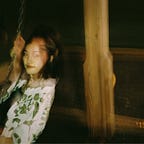Spacial Experience
In this project we will use a kit of parts to design spaces and experiences. It will include the exploration
of modules, grids, and patterns that will lead to three dimensional forms in a consistent manner. We will
also experiment with a few design elements, such as scale, color, and lighting, that designers use to
shape user experiences and perceptions in space.
First Step:
I am about to create individual modules and explore spatial experience by building structure with those modules.
To start with, I did not know what features a module needs to possess to create a systematic structure, how the direction of slit will affect the “spine” of the entity, or how the “rule” of construction plays a part in this process. I decided to learn it by making modules that are very different from each other. However, it was hard to imagine how well each module will turn out in 3D space. The first two modules failed in forming an obsevable pattern.
From observation, I learned that the angle formed by two opposing slides will influence the shape of the “spine”. Seeing from the photo below, the first and the second structures are created with the exact same module except that the first one’s diagonal is folded.
After class critique, I think I gain more understanding of the rules and geometry, so I did step once again.
Module 1
Configuration I
Left: Step 1
Right: assemble the two.
Rule: keep adding pieces on the left and right.
Configuration II:
Rule:create parallelogram shape set, create mirrored set, and put different set next to eachother.
Module 2
Configuration I:
Rule: wedge the middle slit into the slits on the side. Only connect the middle slits when the two sides are complete.
Configuration II:
Step 1:
Rule:wedge the silts on the side with silts on the side until a hexagon is formed, and connect slits that face inward with slits on the side.
Module 3
Configuration I:
Configuration II:
April 16
Step 1: Develop up to 3 modules for one structure that are 2in x 2in and make a minimum of 25 individual modules.
Step 2: Choose a verb, such as sit, climb, crawl, or jump, to derive the form of 1 occupiable space/structure with this larger module(s) (you just need 1 verb). Add a scale model of a person into the space (think about how large your person should be).
Step 3: Draw the form with multiple people interacting with it using your verb. (you need to pick one view of your model to draw and then draw multiple people interacting with it)
Step 1:
Step 3:
I decided to build the structure first and the decide the verb.
Step 2:
Verb: Sit/rest.
Iteration 1
Apr 22th
Iteration 2
Using the existing structure, add some color (color the paper directly, tape/glue on magazine/catalog pages, packaging, etc.) and take close up photos of it in different lighting conditions. You don’t have to set out with an intention of the moods you want to create. Instead, we’ll discuss on Thursday how the color and different lighting impacted the space. Then over the weekend you can remake your model at a higher level of craft, if you’d like, and work towards refining a particular mood/set of adjectives.
Adjectives:
- cyberpunk
- spooky
- mysterious
Verbs:
- immerse
- observe
- walk through
Apr 27th
Iteration 3
After covering up some pieces with magazine cut-outs, I felt that the structure is becoming less defined because the patterns are too overwhelming and inconsistent.
I decided to use aluminum foil to cover up the rest of the pieces but still keep some of the colorful ones to represent screens and advertisement in the space.
Iteration 4
interview:
friend 1: aggressive but cute, like a small angry barking puppy.
mom: Fantasy, outer space. “The photos you took are really not informative enough for people to make judgement.”
friend 2:Scorpio,Disorder. Might want to climb on the sturcture.
Feedback:
- the structure does not seem very intentional.
